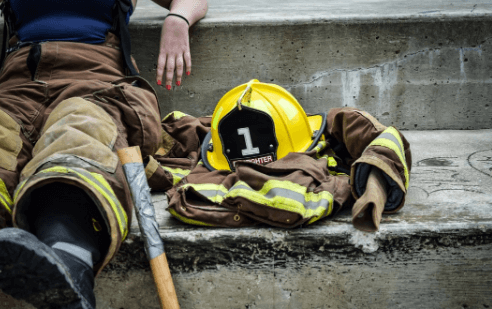Justify The Need For Fitness Evaluations For Those Wishing To Become Firefighters

Firefighting is a physically demanding profession that requires individuals to possess exceptional strength, endurance, and agility. Firefighters must be able to carry heavy equipment, navigate through confined spaces, climb ladders, and operate machinery while under stress. Due to the strenuous nature of the job, it is essential that those wishing to become firefighters undergo rigorous fitness evaluations to ensure they are capable of performing their duties safely and effectively.
Fitness evaluations for firefighters serve as an important tool in assessing an individual’s physical ability to perform firefighting tasks. These evaluations measure various aspects of fitness such as cardiovascular endurance, muscular strength and endurance, flexibility, coordination, and balance. By evaluating these components of fitness before an individual begins training or enters the workforce as a firefighter, potential health risks can be identified early on and appropriate measures can be taken to mitigate them.
In this article we will explore the importance of fitness evaluations for those wishing to become firefighters, the types of fitness assessments used in firefighter selection processes and how individuals can prepare themselves for these tests.
The Demanding Physical Requirements of Being a Firefighter
The strenuous and physically-demanding nature of firefighting necessitates a comprehensive understanding of the fitness requirements for applicants seeking to become firefighters.
Physical training is essential for firefighters as they are required to carry heavy equipment, climb ladders, and perform search and rescue operations in hazardous environments.
The job also requires prolonged periods of standing, walking, and running at full speed while wearing protective gear that can weigh up to 50 pounds.
Fitness evaluations ensure that candidates have the strength, endurance, flexibility, and agility necessary to perform these tasks safely and effectively.
Injury prevention is another critical aspect evaluated during fitness assessments as firefighters are at risk of sustaining various injuries such as sprains, strains, fractures, or burns while on duty.
Therefore, it is crucial that aspiring firefighters undergo rigorous physical evaluations before being admitted into fire service training programs to ensure their ability to handle the demands of the job.
The Importance of Fitness Evaluations
Undoubtedly, a physically fit individual is essential for firefighting duties. The role of fitness evaluations in injury prevention cannot be overstated.
Firefighters are subjected to extreme physical stress and strain which can lead to injuries if their bodies are not in optimal condition. Fitness evaluations help identify any potential health issues or physical weaknesses that may increase the likelihood of injury during firefighting operations.
Additionally, the impact of fitness evaluations on job performance cannot be ignored. Fit firefighters are able to perform their duties more efficiently and effectively, as they have the strength, endurance, and agility required for the job.
Therefore, fitness evaluations are crucial in ensuring that only individuals who meet the required physical standards become firefighters, ultimately reducing the risk of injury during operations and improving overall job performance.
Types of Fitness Evaluations
There are various types of fitness evaluations that can be used to assess the physical readiness of potential firefighters.
These evaluations include strength and endurance tests, cardiovascular fitness assessments, flexibility assessments, coordination tests, and agility tests.
Each type of evaluation is designed to measure specific aspects of physical fitness and can provide valuable information for determining whether an individual is capable of performing the demanding tasks required in firefighting.
Strength and Endurance Tests
Assessing an applicant’s ability to perform strength and endurance tests is crucial for determining their physical readiness for the demanding role of a firefighter. Muscle strength assessments and endurance capacity tests are two types of evaluations that can provide valuable insight into an applicant’s overall fitness level.
Muscle strength assessments measure an individual’s maximum force output in various exercises, such as bench press or leg press. Endurance capacity tests assess an individual’s aerobic fitness through activities like running or cycling. These evaluations help identify any weaknesses or potential areas for improvement in an applicant’s physical abilities, ensuring they can handle the rigorous demands of firefighting tasks.
The ability to maintain peak performance during long hours, high-stress situations, and physically demanding tasks is essential for firefighters to execute their duties effectively and safely. Therefore, incorporating these types of fitness evaluations into the recruitment process is necessary to ensure that only individuals who meet the required physical standards are selected to become firefighters.
Cardiovascular Fitness Assessments
Cardiovascular fitness assessments are like a window into an applicant’s overall physical health, providing valuable insight into their ability to perform the demanding tasks required of firefighters. These assessments can be used to evaluate an individual’s endurance and stamina, as well as their heart and lung function. Assessment methods may include treadmill tests, cycle ergometry, or step tests.
Age restrictions may also be in place for certain assessments to ensure that individuals are physically capable of performing the task at hand. By incorporating cardiovascular fitness evaluations into the firefighter selection process, fire departments can ensure that they are selecting individuals who possess the necessary physical capabilities to safely and effectively perform their duties on the job.
Flexibility, Coordination, and Agility Tests
Flexibility, coordination, and agility tests are additional assessments that can provide insight into an applicant’s physical abilities and suitability for the demands of firefighting. These tests evaluate an individual’s range of motion, balance, reaction time, and spatial orientation.
Firefighters need to be able to navigate through tight spaces, climb ladders with heavy equipment, and carry victims while maintaining balance on unstable surfaces. By assessing flexibility, coordination, and agility during the hiring process, fire departments can identify individuals who may be at a higher risk for injury or unable to perform essential job functions.
Additionally, stretching routines and proper warm-up techniques can help prevent injuries on the job. Incorporating these assessments into the fitness evaluation process can ensure that only physically capable individuals are selected for firefighting positions.
Preparation for Fitness Evaluations
To adequately prepare for the fitness evaluations required to become a firefighter, individuals must engage in rigorous training routines that incorporate a variety of exercises targeting strength, endurance, and agility.
This preparation should also include proper nutrition tips and guidance from personal trainers to ensure that individuals are fueling their bodies with the necessary nutrients needed for optimal performance during the evaluations.
Personal trainers can also provide tailored workout plans to address any areas of weakness or improve overall fitness levels.
It is essential for aspiring firefighters to take this preparation seriously as it not only increases their chances of passing the fitness evaluations but also ensures they are physically prepared for the demands of firefighting duties.
Challenges and Obstacles
One of the challenges faced by individuals preparing for firefighter fitness evaluations is developing a training routine that targets all necessary areas of strength, endurance, and agility.
This can be particularly challenging as different exercises target different muscle groups and require varying levels of intensity.
Additionally, it can be difficult to balance training with injury prevention, as pushing oneself too hard can lead to physical strain or other injuries that could impede progress.
To overcome these obstacles, individuals must carefully craft their training programs to include a variety of exercises that target all necessary areas while also taking care to prevent injury through proper warm-ups and cool-downs, stretching routines, and other techniques aimed at minimizing the risk of injury.
Benefits of Fitness Evaluations
Fitness evaluations for aspiring firefighters have numerous benefits that extend beyond just passing the initial physical requirements. These evaluations can lead to improved health and fitness, which are essential for a career in firefighting.
Additionally, they provide opportunities for career advancement by demonstrating a commitment to maintaining physical standards and increasing confidence and self-esteem among individuals seeking this demanding profession.
Overall, fitness evaluations play a critical role in preparing and shaping qualified candidates who possess the necessary skills and attributes required of firefighters.
Improved Health and Fitness
Improved health and fitness levels are essential for firefighters to perform their job duties safely and effectively, as studies have shown that the physical demands of firefighting can be highly strenuous and unpredictable.
For example, a study conducted by the National Institute for Occupational Safety and Health found that firefighters had a significantly higher risk of cardiovascular disease compared to the general population, highlighting the importance of maintaining optimal health and fitness levels in this profession.
Fitness evaluations can help identify potential health risks early on, allowing firefighters to take preventative measures to reduce their risk of injury or illness.
Regular exercise and healthy habits not only reduce the risk of heart disease but also decrease stress levels, improve mental clarity, boost immunity, enhance endurance capacity, among other benefits.
Incorporating these practices into daily routines improves overall quality of life while enabling firefighters to perform their tasks more efficiently.
Ultimately, maintaining optimal health through regular fitness evaluations is critical for firefighters’ safety and effectiveness in performing their duties while protecting civilians from harm’s way during emergencies.
See also Discover how Jomo Kenyatta Caused Discontent During His Rule In Kenya By
Career Advancement Opportunities
Career advancement opportunities for firefighters are numerous and can include promotions to higher ranks, specialized training in areas such as hazardous materials or technical rescue, and leadership positions within the department. However, these opportunities often require individuals to meet certain fitness standards. Fitness evaluations are necessary to ensure that firefighters have the physical ability to perform their job duties safely and effectively.
Without proper fitness levels, individuals may not be able to handle the physical demands of firefighting tasks or may put themselves and others at risk during emergency situations. Additionally, maintaining a high level of fitness can also lead to increased career growth and advancement opportunities within the profession. Firefighters who prioritize their health and fitness are more likely to be considered for leadership roles or specialized training programs than those who do not prioritize their physical well-being.
Therefore, it is crucial for those wishing to become firefighters to undergo regular fitness evaluations as part of their career development journey.
See also It’s Cool When They Do It It’s A Problem When I Do It Lyrics
Increased Confidence and Self-Esteem
Moving on from the topic of career advancement opportunities, it is important to highlight another crucial benefit of fitness evaluations for aspiring firefighters.
By undergoing regular assessments and training, individuals can experience increased confidence and self-esteem.
This is a particularly significant advantage in the high-pressure work environment that firefighters operate in, where quick decision-making and physical agility are essential.
In addition to these practical benefits, there are also mental health benefits associated with maintaining a fit and healthy lifestyle.
Regular exercise has been proven to increase motivation levels and boost mood, which can have a positive impact on all areas of life.
Therefore, incorporating fitness evaluations into the recruitment process for firefighters not only ensures they are physically capable but also promotes their overall wellbeing.
Conclusion
The demanding physical requirements of being a firefighter cannot be overstated. As first responders, firefighters must be able to perform physically demanding tasks in high-pressure situations where seconds can mean the difference between life and death. Therefore, it is crucial that fitness evaluations are conducted for those wishing to become firefighters.
Fitness evaluations provide an objective measure of an individual’s physical abilities and limitations. These tests assess an individual’s cardiovascular endurance, muscular strength and endurance, flexibility, and body composition. By evaluating these factors, fire departments can ensure that their personnel are physically capable of performing the duties required of them.
One interesting statistic that highlights the importance of fitness evaluations is that 45% of firefighters who die in the line of duty do so as a result of heart attacks or other medical conditions related to poor physical health. This statistic underscores the need for regular fitness evaluations to identify potential health risks among firefighters before they become critical issues.
Firefighters face unique challenges and obstacles on the job, which makes maintaining optimal physical fitness all the more important.
In conclusion, fitness evaluations are essential for those seeking to become firefighters and for current firefighters looking to maintain peak physical condition throughout their career. By assessing an individual’s physical capabilities objectively through various types of assessments coupled with proper preparation techniques, we can ensure that our firefighting personnel have what it takes when called upon to save lives at any moment’s notice.




